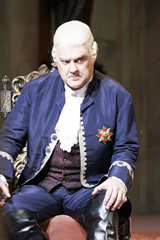| Opera Reviews | 26 April 2024 |
Bryn Terfel dominates in this Toscaby Moore Parker |
|
| Puccini: Tosca Vienna State Opera 19 January 2014 |
|
|
After an absence of some six years from the State Opera, this evening saw not only the Welsh singer's return to the house, but his first appearance here as Scarpia. Initially sounding like a high-lying Italianate baritone in placement rather than the familiar bass-baritone timbre of his Figaro or Falstaff, Terfel instantly claimed the stage with his impressive stature and well-considered approach. Each movement, each phrase, carried a message - the sotto voce asides perfectly cast, and with Scarpia's imposing passages transported as much through emphatic phrasing and timing as through sheer vocal prowess. The "Te Deum" perhaps lacked the sheer vocal weight of Taddei or the snarl of Gobbi, but certainly approached the scale of those singers' monumental interpretations. Oddly, Act two seemed to bring a slight clouding in timbre, but nonetheless he continued to offer a wealth of detail and resources to dominate throughout - and to score an ultimate triumph. In the title role, Martina Serafin gave a solid - if rather run-of-the-mill - interpretation. The voice is sufficiently large in size, though with a tendency to splay and harden above the stave. More important, the reading could benefit from greater variety in colour and dynamics at times. Too many moments ring hollow - "Quanto?", "Il prezzo?", or the three cries of "Muori! Muori! Muori! in Act two being just a couple of examples. "Vissi d'arte" was actually the most heartfelt moment of the interpretation - hinting, perhaps, at further potential. Massimo Giordano's youthfully attractive Cavaradossi came across as an overzealous lover with no chance of success when lunging against Scarpia's massive chest in Act two, and displaying little optimism in the Act three finale despite Tosca's positive news. Greater security and contrast between the lyrical and more dramatic moments might have helped counter this rather unpolished and uncompelling reading. Throughout, an occasional ringing top note ("Recondita armonia's" final phrase; "...Tosca sei tu", for example) would be followed by patchy - almost insecure - moments in emission. "E lucevan le stelle" failed to bring spontaneous applause, but the conductor paused in any case - thereby insisting that this was a moment in which appreciation was expected. Janusz Monarcha and Alfred Sramek deserve a mention among the supporting roles for their tried-and-trusted Angelotti and Sacristano. In the pit, Paolo Carignani's fiery approach tended to produce runaway tempi and an excess in decibels (perhaps evidence of a meager rehearsal schedule). In certain respects a Tosca to echo musicologist Joseph Kerman's acerbic description of the piece as a "shabby little shocker" - however one which appeared to send home a satisfied audience after the final curtain. |
|
| Text ©
Moore Parker Photo © Wiener Staatsoper / Michael Pöhn |

 This
Margarethe Wallmann production (dating from 1957 when it premiered with
Tebaldi in the title role and von Karajan conducting) opened rather
drearily in this revival, with comings and goings rather by the book
and with little in the way of inspiration - until the appearance of
Bryn Terfel as Scarpia. In a flash, the stage and auditorium were infused
with energy, and a sense that this man meant business.
This
Margarethe Wallmann production (dating from 1957 when it premiered with
Tebaldi in the title role and von Karajan conducting) opened rather
drearily in this revival, with comings and goings rather by the book
and with little in the way of inspiration - until the appearance of
Bryn Terfel as Scarpia. In a flash, the stage and auditorium were infused
with energy, and a sense that this man meant business. 





